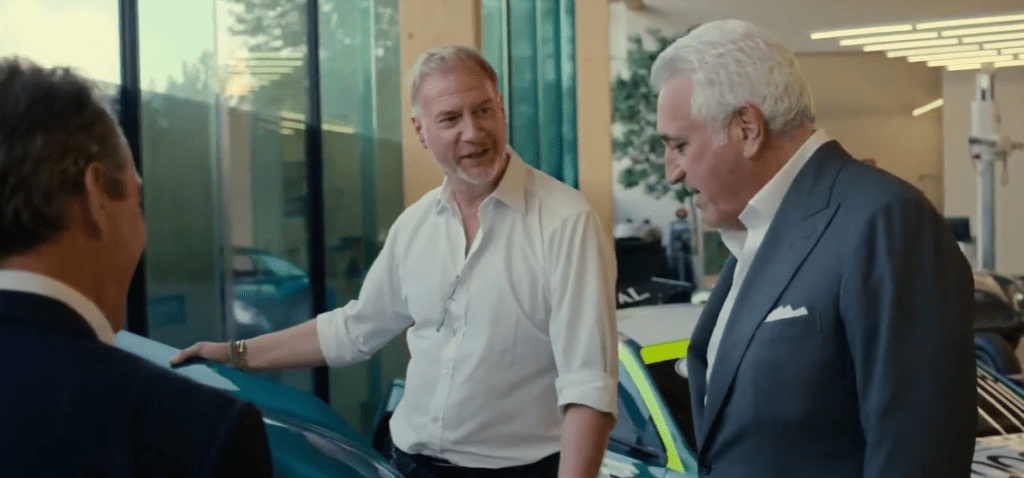Lawrence Stroll Biography & Career Table
| Category | Details |
|---|---|
| Full Name | Lawrence Sheldon Strulovitch |
| Known As | Lawrence Stroll |
| Date of Birth | July 11, 1959 |
| Age | 65 years old |
| Nationality | Canadian |
| Spouse | Raquel Diniz (m. 2020) |
| Children | Lance Stroll, Chloe Stroll |
| Main Business Ventures | Sportswear Holdings, Aston Martin, Racing Point, Michael Kors, Tommy Hilfiger |
| Net Worth (2025) | $3.8–$3.9 billion USD (Forbes) |
| Key Assets | Aston Martin stake, F1 Team ownership, car collection |
| Reference Source | Forbes Profile |

Lawrence Stroll, a billionaire whose influence is especially felt, rose through the nexus of luxury fashion and motorsport. His net worth is close to $3.9 billion as of 2025, making him one of the most wealthy individuals in the Formula 1 paddock. His calculated flexibility and long-term vision are evident in his strategic journey from marketing Ralph Lauren in Europe to influencing Aston Martin’s future.
Stroll co-founded Sportswear Holdings with Silas Chou, an investor from Hong Kong. This strategy proved to be extremely successful, launching Tommy Hilfiger and then Michael Kors into enormous success. In addition to elevating fashion labels, their combined efforts revolutionized retail strategy, particularly in international markets where aspirational branding flourished. By 2011, Sportswear Holdings had grown from an initial investment of $85 million to a company valued at $3.6 billion, all thanks to Michael Kors. A very profitable chapter came to an end in 2014 with their final exit.
Stroll’s move into motorsports over the last ten years was not just an indulgence; rather, it was a strategic turn into a prestigious industry with global recognition, technology, and devoted followers. In addition to saving a dwindling brand, he established the foundation for his family’s legacy by spearheading a consortium to purchase the now-defunct Force India team. In 2021, Stroll changed the team’s name to Racing Point and then to Aston Martin F1, demonstrating how timing and vision could significantly enhance a risky investment.
As Stroll’s son, Lance, rose through the Formula racing ranks, this turn into high-stakes motorsport had symbolic overtones. Instead of keeping family and business apart, he combined the two paths. Lance benefited most from this, as he was able to access not only a car but also a team that was designed for expansion. Despite accusations of nepotism, Stroll’s management and financial support greatly lowered the discrepancy between expectations and results.
His enthusiasm for cars extends beyond racetracks. Some of the rarest Ferraris on the planet, including the 1963 Ferrari 250 GTO, 1967 Ferrari 330 P4, and a 1996 McLaren F1, are in Lawrence Stroll’s personal collection. These vehicles are investments that increase in value over time, not just awards. By building one of the world’s most renowned auto stables, he has achieved both financial stability and symbolic prominence.
Stroll doubled down during the pandemic, when many sectors were struggling. He oversaw the Yew Tree consortium’s £182 million investment in Aston Martin, which resulted in a 16.7% ownership stake. He displayed a particularly creative tactic that blended performance and glamour by tying luxury cars to Formula One branding. Aston Martin’s comeback was a declaration of elite consistency rather than merely an engineering feat.
Stroll’s financial situation puts him in a unique position when compared to other billionaire team owners like Toto Wolff ($1.8B) or Michael Latifi ($3.5B). His rise has been remarkably natural; he has always recognized timing and opportunity, going from his family’s fashion business roots to international boardrooms. His wealth is a prime example of the contemporary billionaire’s strategy, which includes diversifying rapidly, customizing the brand, and never pulling out of legacy investments.
This philosophy is reflected in his personal life as well. His family actively and visibly shapes public perception. He is married to fashion entrepreneur Raquel Stroll and is the father of F1 driver Lance and professional singer-songwriter Chloe. Stroll’s influence is felt in both business and celebrity circles, especially at high-profile events like Chloe’s wedding to Olympic snowboarder Scotty James. In fields where leverage is based on reputation, this kind of visibility is very valuable.
Team valuations have gained momentum in recent years due to conversations about Formula One’s growing commercial appeal, which is fueled by streaming services and Netflix’s Drive to Survive. Team owners like Stroll benefited from unanticipated windfalls as Formula 1’s fan base grew among younger audiences. Suddenly, his investment in Aston Martin appeared incredibly straightforward from a branding and business standpoint.
Through the use of his fashion capital and its transformation into motorsport influence, Stroll has developed a unique blueprint. It’s a model that blends public spectacle with personal passion. The majority of billionaires stay hidden, but Stroll’s presence in boardrooms and pit lanes adds a story that viewers will remember.
The future impact of Stroll is probably going to depend on how well Aston Martin does in Formula One and how the automaker positions itself in the market for electric vehicles. However, his history indicates that he is far from finished. Stroll keeps evolving by means of strategic alliances, an understanding of luxury brands, and an acute sense of talent, whether it be racing engineers or fashion designers.
